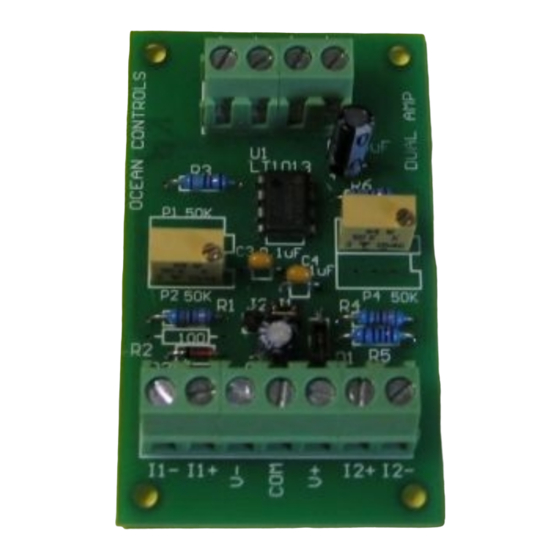
Advertisement
Often you want a simple amplifier to amplify or attenuate the signal you are feeding into a data acquisition system.
For example you have a signal from a temperature sensor that is providing 10mV/deg but you are only operating
over 0-40 degrees giving an effective span of 0 to 0.4V. Your data acquisition system accepts a signal of 0 to 10V
so you would like to amplify your signal by 10 to get better resolution.
Or you may have a 48V battery that you wish to monitor with a data acquisition system that has a 0 to 5V input
range. You could use a simple voltage divider but the input impedance of the data acquisition is only a few kilo-
ohm.
Or you may have a 4-20mA signal you wish to convert to 2 to 10V or 1 to 5V
This Dual DC amplifier provides a solution to these problems and more
The dual DC amplifier circuit consists of two non inverting amplifiers (OP1 and OP2) with a voltage divider at the
input. The dual operational amplifier used is a Linear Technology LT1013 which features low offset voltage and can
be powered from a unipolar or bipolar supply.
Each amplifier is identical in design and is issued with one 50K potentiometer. Whether the circuit amplifies or
reduces the signal depends on where the 50K potentiometer is placed on the circuit. Because each amplifier is
identical we are only going to refer to the circuit using operational amplifier OP1. If you place the pot in position P2
the circuit operates as an attenuator or voltage divider. If you place it position P1 it becomes a non inverting
amplifier.
Voltage Divider
If the potentiometer is fitted in position P2 then the combination of resistor R2 and P2 act as a voltage divider and
the operational amplifier is configured as a voltage follower with a gain of 1. This gives an effective gain of
P2/(R2+P2)
This will allow you to adjust the gain between 0.667 and 0.1 easily
Non Inverting Amplifier
If the potentiometer is fitted in position P1 then the combination of OP1, R3 and P1 act as a non inverting amplifier.
Each amplifier has a variable gain feedback with the gain
1 + R3/P1
This will allow you to adjust the gain between 1.5 and 10 quite easily.
Filter
The effect of R3 and C3 is to provide a simple low pass filter to filter out high frequency noise. When the circuit is
operating as a Non Inverting amplifier the effect of high frequency noise is more pronounced.
Connecting 4-20mA Signals
If you wish to convert a 4-20mA signal to a voltage signal insert the 100 ohm resistor R1. This will convert the 4-
20mA signal to a 0.4 to 2Volt signal. You can then adjust the Non Inverting Amplifier to the voltage span you
require.
Power Supply
The circuit board can be supplied with a +12 and -12V or a +15 and -15V supply so that both positive and negative
signals can be amplified. The jumper should be placed in position J2.
If you are only interested in positive signals then the circuit can be supplied with a voltage from +12V to +24VDC.
The jumper should be in position J1.
28 Jul 2010
Dual DC Amplifier / Attenuator
•
Dual op-amp board
•
Each can be configured for Amplification or Attenuation (voltage divider)
Single or Dual voltage supply
•
Gain from 0.1 to 0.7 or 1.5 to 10
•
www.oceancontrols.com.au
KTA-200 Dual Amplifier / Attenuator
1 of 3
Advertisement
Table of Contents

Summary of Contents for OCEAN CONTROLS KTA-200
- Page 1 KTA-200 Dual Amplifier / Attenuator Dual DC Amplifier / Attenuator • Dual op-amp board • Each can be configured for Amplification or Attenuation (voltage divider) Single or Dual voltage supply • Gain from 0.1 to 0.7 or 1.5 to 10 •...
- Page 2 KTA-200 Dual Amplifier / Attenuator Assembling the Kit First solder in place all the resistors (leave out resistors R2 and R5 for voltage signals, solder them in for 4-20mA signals) and terminals. Next solder in place all the capacitors noting the polarity of the electrolytic capacitors.
- Page 3 KTA-200 Dual Amplifier / Attenuator KTA-200 0: Amplifier / Attenuator Kit 1: Dual Amplifier Assembled 2: Dual Attenuator Assembled 3: Amplifier / Attenuator Assembled 4: DIN Rail mount to suit KIT: Supplied as kit, requires assembly KTA: Assembled unit Quick Setup Notes:...
Need help?
Do you have a question about the KTA-200 and is the answer not in the manual?
Questions and answers